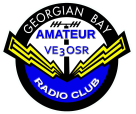2020-12-04, 14:10:48
A screen capture of the critical frequency (foF2) from the ionosonde at Alpena, Michigan taken today shows encouraging signs for renewed NVIS (Near Vertical Incidence Skywave) activity on 40m. Typically, reliable communications using NVIS are made at a frequency about 20% below the critical frequency. Although today's plot shows frequent peaks in the 40m range it is too early in the solar cycle for regular NVIS operation on that band.

Note that even 80m is only useful from 13:00 - 23:00 UTC (8:00 am - 6:00 pm local) for NVIS. The fact that we can still hold the GBARC HF net on 80m outside this window suggests that ground wave propagation is being used for stations in the GBARC region. Ground wave propagation is enhanced by using a vertically polarized antenna. Those of us with horizontally polarized antennas (like mine) are at a disadvantage.
Remember that the propagation pattern for a NVIS antenna shows most of the energy going straight up at 90 degrees to the horizon in a classic "cloud burner" manner. At the same time, a useful amount of energy is still available at lower angles for mid-range or ground wave communication. Thus a AS2259-style 40m/80m inverted-V dipole is still useful even though it will only work on 80m during the daytime for true NVIS propagation.

Note that even 80m is only useful from 13:00 - 23:00 UTC (8:00 am - 6:00 pm local) for NVIS. The fact that we can still hold the GBARC HF net on 80m outside this window suggests that ground wave propagation is being used for stations in the GBARC region. Ground wave propagation is enhanced by using a vertically polarized antenna. Those of us with horizontally polarized antennas (like mine) are at a disadvantage.
Remember that the propagation pattern for a NVIS antenna shows most of the energy going straight up at 90 degrees to the horizon in a classic "cloud burner" manner. At the same time, a useful amount of energy is still available at lower angles for mid-range or ground wave communication. Thus a AS2259-style 40m/80m inverted-V dipole is still useful even though it will only work on 80m during the daytime for true NVIS propagation.



